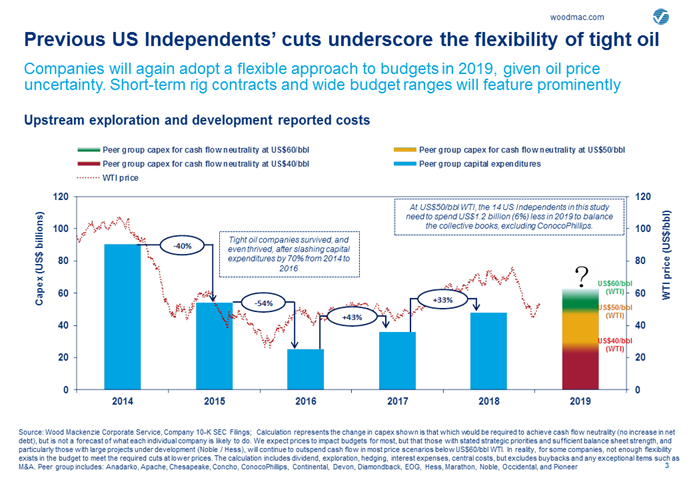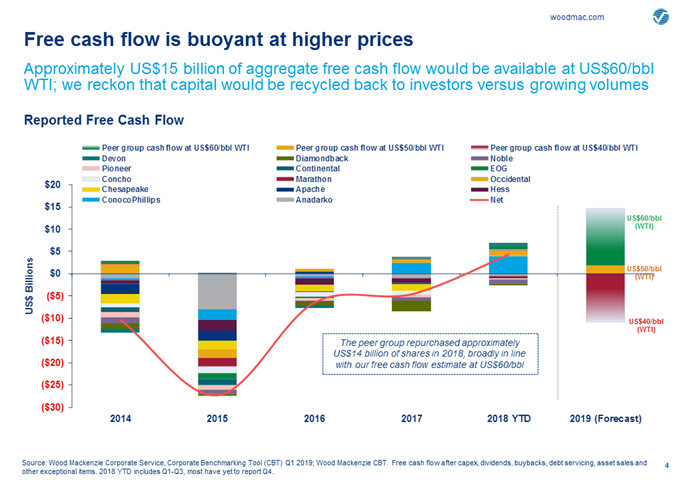Discuss your challenges with our solutions experts
How will US independents answer the call for capital discipline?
Balancing the books: US Independents’ 2019 cash flow versus capex
1 minute read
The Lower 48 E&P sector is under pressure from investors, who are demanding greater capital discipline, positive free cash flow and increasing returns. Our latest research highlights the actions required to find the sweet spot on the value versus volume seesaw.
How will the growth-hungry independents adjust 2019 spending plans in response to volatile oil prices?
As US independents continue to release budgets this month, we expect growth aspirations to take a back seat. Cash flow neutrality is more important than ever – and it will remain front and centre of corporate messaging. Investment budgets will be adjusted down as oil price expectations have slipped. But at prices above US$50 a barrel, shareholder distributions will be higher up the capital allocation pecking order than investing for growth. Organic free cash flow – if generated – will play an important role in sustaining share buyback momentum.
Cash flow neutrality in 2019?
With prices at US$50/bbl WTI, we estimate that US independents need to cut spending by 6% relative to 2018 levels to achieve cash flow neutrality this year. But the size of the cut and the likely reaction varies considerably across the peer group.
Hess, Apache and Noble are under the most pressure at US$50/bbl, but are focused on delivering large-scale capital intensive projects in 2019. Many companies have already set activity levels with the aim of being neutral around US$50/bbl, most notably tight-oil stalwarts Pioneer, Concho and Continental.
US$15 billion of free cash flow at US$60 a barrel of WTI
Free cash flow generation at US$60/bbl is broadly in line with the scale of share buybacks undertaken in 2018 (US$14 billion). But asset sales proceeds will be lower in 2019, following the portfolio adjustments that have taken place since 2014. Buybacks and debt repayment are likely to soak up the majority of the surplus free cash flow at higher prices.
You might also be interested in:
- Can exploration stay profitable in 2019?
- How explorers can make money - three strategies
- How digitalisation transformed the US Lower 48
There are a number of key issues to watch this year. Those with the strongest tight oil portfolios will find it tempting to relax capital discipline at prices higher than US$50/bbl.
Top-flight operators such as Pioneer, EOG and Concho command vast tight oil positions in the Permian with NPV 15 breakevens below US$40/bbl WTI. These low breakeven assets underscore the strong incentive to invest. But we expect shareholders to be favoured in the distribution of surplus cash flow – moderate dividend increases for some; buyback programmes for most.
More leveraged players with weaker free cash flow outlooks are more challenged at lower prices. Having divested over US$50 billion of assets since 2015, most of the low-hanging fruit has already been sold, highlighting the pressure for companies such as Apache and Chesapeake to dial down capital expenditures at lower prices. Expect fast reactions to price signals.
Consolidation is likely to remain a core theme – driven by a variety of strategies including the desire to improve returns, deleverage via equity-backed corporate acquisitions, or simply opportunistically taking advantage of valuation multiples in an unloved sector.







